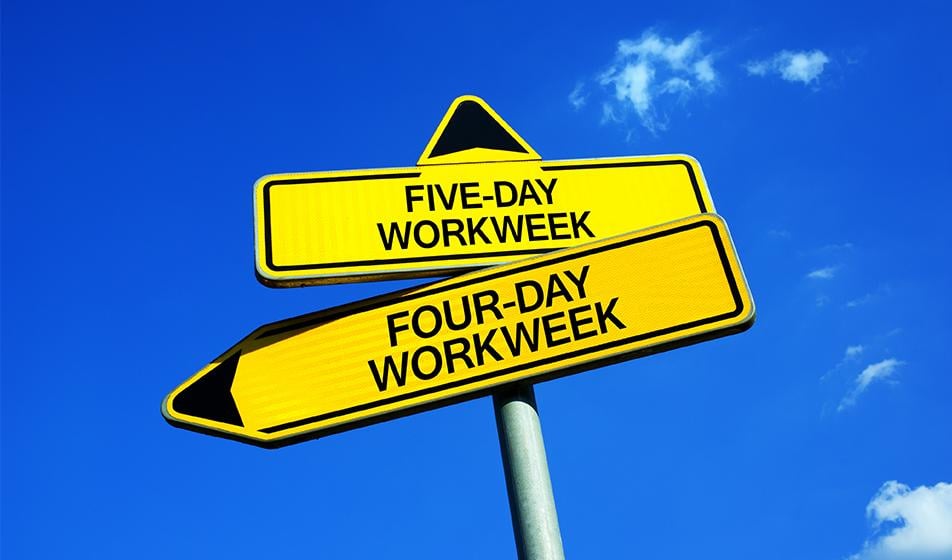The landscape of flexible working has changed drastically over the past few years. Even before the pandemic, employers were adopting flexible working policies. And hybrid working models are now common, though few of us had even heard of them a couple of years ago.
But adapting to flexible policies doesn't mean that work has to suffer- far from it. Our Culture Economy Report revealed that 9 in 10 SMEs maintained productivity levels whilst working remotely during the pandemic. And with employees now permitted to request flexible working from the first day of employment as of April 2024, there are ever more reasons to implement some form of flexible work.
So, if you're an HR manager who's currently perched on the flexible-working fence and not sure which side to take; read on.
We'll explore:
- What is flexible working?
- Types of flexible working
- Why it's beneficial for SMEs?
- Advantages:
- What are the disadvantages of flexible working?
- Why Breathe chose a flexible working policy
- Is flexible working right for your business?
The office is running smoothly, your employees are in at 9 and leave at 5:30. It’s seems productive and you’re happy. But then Sally in accounts asks to work at home one day a week, David from sales wants to go part-time and Denise puts in a request to start later on certain days. But can it really work? Here's what we found.
Managers who sway towards the more agile mindset are finding that flexible working hours and locations can help towards managing external work-life stressors.
As more companies attempt to adapt to the increasing demands of mobile and agile workforces, HR managers and SME business owners are left wondering whether flexible working can work for their business. Let's delve in.

What is flexible working?
An alternative to traditional working hours, flexible working includes working from home or flexible start and finish times. Whether it's part-time working, compressed hours, job sharing, early finishes, late starts, working from home or away, logging on at cafés, hot desking or even picking your own hours, flexible working helps to put people first.
By tailoring working-hours and locations to suit your employees and business you can help save valuable time and stress across the workplace.
Employees have a right to ask for flexible working. We believe it's best to view the switch as an opportunity for your business to develop and test out some of the components of agile working.
Indeed, a Working Families survey found a 15% increase in the number of parents who work flexibly - 70% in late 2021 vs. 55% in 2019.
Thanks to clever HR software and advances in technology, flexible working is now easier to manage. What with the advance in video conferencing, storing documents in the cloud and readily available mobile WiFi, it’s not always necessary for staff to complete their jobs by being physically present in an office.
What does flexible working mean?
There are many different ways of working flexibly. These include:
-
Part-time working – employees are contracted to work less than standard, basic, full-time hours.
-
Working from home – employees will spend all or part of the week working from home or somewhere else away from the working premises.
-
Job sharing – a full-time job can be split between two employees who agree the hours between them.
-
Compressed hours – employees cover their standard working hours in fewer working days.
-
Flexi-time – employees have the freedom to work in any way they choose outside a set of core hours determined by the employer.
-
Phased retirement - since the phase out of the default retirement age in April 2012, mature workers can now decide what age they wish to stop working. This means they can reduce their hours and work part time.
Before the law changed, the rules in the working world were much more rigid. This change in law intended to encourage a much wider range of applicants to submit requests to their employers.
Calculate UK part-time and pro-rata holiday allowances with Breathe's handy holiday calculator.
Flexible working for SMEs: the benefits
One of the biggest misconceptions about flexible working is that it's only relevant for parents, guardians or carers. That's no longer the case.
Flexible working is particularly well-suited to SMEs due to company size and logistics. As a small business, incorporating those ideals into your company can seem counterproductive initially. However as well as increasing your staff retention rates, improving workforce happiness and productivity, you'll also have a wider pool of talent to choose from when it comes to recruiting.
And then there's the benefits for employees. They speak for themselves. It can help staff feel less watched and micromanaged, and encourage independent thinking and problem solving.
The benefits of flexible working are widely noted. One study found that the productivity of flexible workers increased by 30%. Another noted that 97% of managers said the quantity of work either stayed the same or increased, and that the quality of work improved or stayed the same for flexible workers.
Advantages of flexible working for employers
Happy workers make productive workers, which means you can enjoy greater growth and a healthier bottom line. Flexible working is a great way to achieve this because it shows you care about your staff’s wellbeing and are actively nurturing your company culture.
It can also help to empower staff by encouraging autonomy, trust and personal investment in the company. Think: 'you scratch my back, I'll scratch yours'.
Offering flexible working when you’re recruiting can also increase the number of potential candidates – some of those might be exceptionally talented and a real asset to your organisation but might not have applied if flexible working wasn’t on offer.
Flexible working isn't just good for recruitment – it can help staff retention too. As well as creating an overall impression that you’re a fair and flexible employer, it can help you keep talented staff whose personal circumstances might have changed and would leave if they couldn’t move to a more flexible working pattern.
Advantages of flexible working for employees
Employees benefit from flexible working because it allows them to fit work around family and personal commitments. For example, an employee who has to start caring for an elderly parent could still carry out their job effectively when working from home two days a week. This relieves added stress while allowing them to juggle both private and work responsibilities successfully.
It also gives employees greater control over their own working schedule and can help reduce commute times & avoid disruption on public transport, for example.
Go one step further and start managing people, not paper, with Breathe's cloud-based, automated HR software. Take the pressure off employee admin by letting them check and request holiday, note sickness, track performance reviews and much more.
Disadvantages of flexible working
It would be nice to say flexible working was perfect in every way but as with all business policies it does have its drawbacks for both employers and employees.
As an employer or manager, you might find certain members of staff take advantage of flexible working a little too much – slacking off or heading out with friends when they should be working for you. Flexible working isn’t great for customer-facing roles either such as for staff working in a shop or assistants in a nursing home. It can also make it much harder to make sure your company’s processes are still carried out as they should be.
Curiously, flexible working isn't always good for staff motivation and morale. The less time in the office, the more chance that they'll miss out on integrating into office culture and your team. However, you can mitigate this by organising work socials and encouraging integration from the top.
Flexible working can impact an employee's home-life routine, blurring the lines between work and personal. If they are constantly checking emails or answering calls regardless what time it is, it can be difficult to switch off and they could be at risk of burnout.
Nip this in the bud before it begins by encouraging your employees to prioritise workloads and set boundaries.
Why Breathe chose a flexible working policy
As a people-first business, it felt like natural progression for us to allow our teams to have more autonomy in their working lives.
We believed this would have a positive impact on engagement and productivity, and that it wold help to recruit and retain the best talent for the business.
Everyone has a statutory right to request a flexible working arrangement from day one of employment under updated flexible working legislation (as of April 2024), but we wanted a more agile scheme that is readily available, offers continuous flexibility and does not require a contractual change.
Is flexible working right for my business?
Flexible working is great for so many employees and, in turn, businesses. For some though, it's simply not worth the stretch. That's why it's vital to evaluate both your team and organisation's strengths, weaknesses and obligations.
For example, do you manage a business that easily lends itself to flexible and remote working, i.e. can your people complete their job away from the office?
If you need employees to be hands on and physically present to carry out their job, then it can prove trickier to implement.
Research has shown staff often value work/life balance more than they do remuneration. By offering flexibility from the get-go you're more likely to attract a more diverse talent pool, improve productivity and manage happier, engaged staff.

Author: Laura Sands
Laura is a writer who enjoys getting into the detail of subjects and sharing that knowledge with snappy, interesting content. When not typing away, she enjoys walks in the woods and curling up with a good book and mug of something hot.




